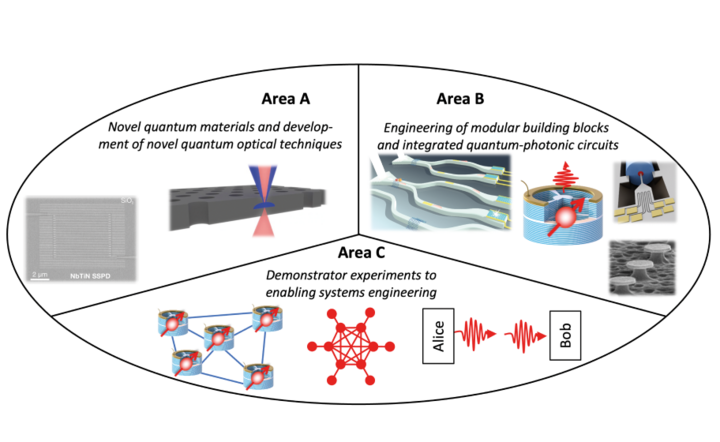Engineering photonic quantum technologies
In the framework of the TUM-IAS Rudolf Mößbauer Tenure Track Assistant Professorship, the Professorship for Quantum Electronics and Computer Engineering was established in 2019 and promoted to W3 Associate Professorship in 2022. The group’s research focuses on quantum engineering of photonic quantum systems.

Focus Group Quantum Electronics and Computer Engineering
Prof. Kai Müller (TUM), Alumnus Rudolf Mößbauer Tenure Track Assistant Professor
Introduction to photonic quantum technologies
The emerging area of quantum technologies holds the promise to revolutionize our world by exploiting fundamental quantum physical effects for technological applications. For example, the European Union’s “Quantum Flagship” mission has identified the four core areas quantum communication, quantum computation, quantum simulation and quantum sensing / metrology as areas where quantum physics will enable new technologies with capabilities far beyond existing technologies. Examples are ultra-secure communication where the security is guaranteed by physical principles, or powerful computers, which can solve specific tasks many orders of magnitude faster than classical computers. This is based on the peculiar properties of quantum mechanics, in particular the ability to control and exploit quantum coherence and quantum entanglement. To this end, photons are a unique type of quantum bits, so-called qubit as, in contrast to all other qubit systems, they do not suffer from decoherence. Moreover, they can be used to transmit quantum information over large distances.
History of the Focus Group
The Professorship of “Quantum Electronics and Computer Engineering” at the Department of Electrical and Computer Engineering, was established in 2019 with the appointment of Kai Müller as Rudolf Mößbauer Tenure Track Assistant Professor. It emerged from a junior research group that he previously established at the Walter Schottky Insititut of TUM funded by a highly-competitive BMBF “Quantum Futur” grant (4.5 million euros for 5 years). Due to the success of the group, Kai Müller obtained early tenure in 2022, after three years as a tenure-track professor. Within the tenure-track period, the group contributed to more than 25 publications (key publications below), grew to a size of more than fifteen doctoral candidates and postdoctoral researchers and acquired several third-party funded projects with a total volume of more than 13 million euros. Among those are multiple collaborative projects where the group’s leader is the coordinator, including the BMBF project “Photonic-Integrated Quantum Computer (QPIC-1),” the DFG major instrumentation initiative “Munich Quantum Communications Laboratory (MQCL)” and the project “6G and Quantum Technologies” funded by the Bavarian Ministry of Economic Affairs.
Research of the Focus Group
The research of the group focusses on the quantum engineering of building blocks and devices that are essential for all areas of photonic quantum technologies. These building blocks are sources of non-classical light such as single-photons or entangled photons, spin-photon interfaces, quantum memories and single photon detectors. Overall, the group’s research spans the entire range from engineering light-matter interactions to demonstrator experiments, which enable systems engineering, and can be divided into three interlinked areas (Figure 1):
Figure 1
Area A
Research area A addresses the investigation of novel optically-active quantum materials and the development of novel quantum-optical techniques. Specific properties that are investigated are quantum-optical and spin coherence properties. Since every quantum material has specific advantages and disadvantages and future systems are likely to be hybrid quantum systems, the group works on a variety of materials, including semiconductor quantum dots, color centers in diamond, rare-earth ions in crystals, atomically-thin transition metal dichalcogenides and superconducting nanowires. Quantum-optical techniques developed by the group are techniques for the coherent-optical control of electronic excitations and spin states, as well as techniques for the generation and detection of non-classical light.
Area B
Research area B addresses the engineering of modular building blocks and quantum photonic-integrated circuits for photonic quantum technologies. Embedding optically-active quantum systems into nanophotonic resonators allows to enhance the light matter interaction thus increasing operational rates. Moreover, tailored nanophotonic resonators allow for efficient photonic interfacing. For modular building blocks, photonic in-coupling and out-coupling efficiencies are key parameters. In addition to working with many different quantum materials, the group also works on a large number of different nanophotonic structures, such as micropillar resonators, photonic crystals and bulls-eye resonators to use for each application the best suitable nanophotonic resonator. In addition, different building blocks can be integrated on a chip to form scalable quantum photonic-integrated circuits.
Area C
Research area C addresses the realization of demonstrator experiments to obtain feedback for the device engineering and to enable systems engineering. Here, the techniques developed in area A and the devices engineered in area B are combined to realize demonstrator experiments such as quantum communication (quantum key distribution and quantum networks), optical one-way quantum computing and quantum simulation (Boson sampling). Results from these experiments give feedback for the device engineering, i.e., which parameters turn out to be particularly important in real-world settings. In addition, the demonstrator experiments enable systems engineering and allow developing protocols for photonic quantum technologies, such as techniques for quantum key distribution, remote entanglement generation and quantum error correction.
In close collaboration with Dr. Matteo Barbone, Dr. Björn Jonas, Dr. Viviana Villafane (TUM), Postdoctoral Researchers | Stefan Appel, Fabian Becker, Katarina Boos, Beatrice Costa, Jan Flaschmann, Lukas Hanschke, Sang Kyu Kim, Marko Petric, William Rauhaus, Friedrich Sbresny, Bianca Scaparra, Christian Schmid, Fabian Wietschorke, Lucio Zugliani (TUM) Doctoral Candidates
Selected publications
-
Villafañe, V. et al. Three-photon excitation of quantum two-level systems. arXiv:2202.02034 (2022).
-
Sbresny, F. et al. Stimulated generation of indistinguishable single photons from a quantum ladder system. Physical Review Letters 128, 093603 (2022).
-
Petrić, M. M. et al. The Raman Spectrum of Janus Transition Metal Dichalcogenide Monolayers WSSe and MoSSe. Phys. Rev. B 103, 035414 (2021).
-
Hanschke, L. et al. Origin of Antibunching in Resonance Fluorescence. Physical Review Letters 125, 170402 (2020).
-
Klein, J. et al. Site-selectively generated photon emitters in monolayer MoS2 via local helium ion irradiation. Nature communications 10, 2755 (2019).
